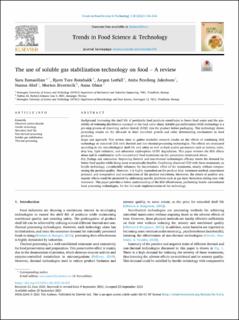The use of soluble gas stabilization technology on food – A review
Esmaeilian, Sara; Rotabakk, Bjørn Tore; Lerfall, Jørgen; Jakobsen, Anita Nordeng; Abel, Nanna Louise; Sivertsvik, Morten; Olsen, Anna
Peer reviewed, Journal article
Published version

View/
Date
2021Metadata
Show full item recordCollections
Original version
Trends in Food Science & Technology. 2021, 118, 154-166. 10.1016/j.tifs.2021.09.015Abstract
Background
Increasing the shelf life of perishable food products contributes to lower food waste and the possibility of widening distribution outreach in the food value chain. Soluble gas stabilization (SGS) technology is a pre-step process of dissolving carbon dioxide (CO2) into the product before packaging. This technology shows promising results on the lab-scale to limit microbial growth and other deteriorating mechanisms in food products.
Scope and approach
This review aims to gather available research results on the effects of combining SGS technology or dissolved CO2 with thermal and non-thermal processing technologies. The effects are structured according to the microbiological shelf life and safety as well as food quality parameters such as texture, color, drip loss, lipid oxidation, and adenosine triphosphate (ATP) degradation. This paper reviews the SGS effects alone and in combination with conventional food treatments on the parameters mentioned above.
Key findings and conclusions
Improving thermal and non-thermal technologies efficacy meets the demand for better food quality while being more economically feasible. Combining dissolved CO2 with these treatments, as hurdle technology, considerably enhances the bacteriostatic effect of the treatments, mostly without compromising the product quality. However, it is highly dependent on the product kind, treatment method, experiment protocol, and composition and concentration of the product microbiota. Moreover, the extent of positive synergistic effects could be promoted by addressing specific problems such as gas layer formation during sous vide treatment. This paper provides a better understanding of the SGS effectiveness, performing beside conventional food processing technologies, for the full-scale implementation of the technology.
